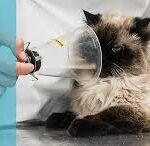Feeding your cat the right diet can help keep them healthy for years to come. Understanding how much to feed your cat plays a key role in maintaining a healthy weight.
Not only does the right type of diet give cats all the nutrients they need, but it can also help improve their dental health and regulate their digestive system.
Keep reading for our advice on the best nutrition for your cat.
The Importance of Balanced Cat Nutrition:
A balanced diet is fundamental to your cat’s health and longevity. It provides the essential nutrients that support bodily functions, maintain a healthy weight, and prevent common health issues. Achieving this balance requires understanding the role of macronutrients – protein, fat, and carbohydrates – and ensuring they are sourced from high-quality ingredients.
Which is the best diet for a cat?

Unfortunately, there’s no one answer to this, as the ‘right’ diet varies depending on your cat’s needs. All cats are obligate carnivores, meaning they need specific vitamins, minerals, and proteins (for example, taurine and arginine) that only come from meat. Without these essential nutrients, your cat can become seriously ill; a taurine deficiency can cause dangerous heart and eye issues and can even cause blindness.
How to choose the right food for your cat
There are various types of cat food available, but balanced, high-quality food is always better than a low-quality alternative. Whichever type you choose, look at the ingredients list. Your vet will be happy to offer tailored advice about your cat’s diet, taking into account their age, lifestyle, and any existing health conditions.
What human food is poisonous to cats?
It might be tempting to share bits of your treats with your cat, but before you do, ensure you learn which foods can be toxic to cats. The below list isn’t exhaustive, and we recommend checking our poisons guide.
- Onions
- Garlic
- Milk and dairy products
- Chocolate
- Grapes and raisins
- Dog food
Should I give my cat wet or dry food?

Many cats are notoriously fussy when it comes to food, so while there are benefits to both wet and dry, the decision may ultimately come down to their preference. Dry food is convenient to store and tends to be better for your cat’s dental health as the hard texture helps remove plaque and tartar, which doesn’t then build up around the gum line. It also contains much less water and has a higher concentration of nutrients, so you don’t need to feed as much.
On the other hand, cats often don’t drink enough water, so wet food can help keep them hydrated. It’s also much easier to eat for cats who are recovering from injury or operation.
Should I stick to the same food throughout my life?
Your cat’s nutritional needs change as they age, so you may need to alter their diet as they grow. For example, kittens under the age of one will need a diet that fuels their energetic lifestyle while supporting healthy brain, eye, and bone development. Similarly, cats over the age of 11 will need to switch to food that supports their mobility and brain function.
How much should I feed my cat?

The amount your cat should eat relates to their breed, age, and size. All cat food has guidelines on the packaging, and this is usually a good place to start. You’ll then need to keep an eye on their weight to tell whether they’re eating too much or too little. Roughly speaking, you should be able to feel, but not see, the last two or three ribs when looking from the side and a clear waistline when looking from above. Your vet will also check your cat’s weight at their next health check to make sure they’re the right size.
Once you’ve settled on the right amount for your cat, it’s a good idea to weigh it out at the start of the day to avoid overfeeding. Cats are commonly overfed, leading to weight gain and further health issues, so this is a key step in maintaining a healthy weight.
How many treats can I give my cat?
There’s nothing wrong with the odd treat, but it’s important not to overdo it, as it can be highly calorific. Always opt for treats that are low in sugar and carbohydrates, and limit the amount you give them. Treats should make up no more than five to 10 percent of your cat’s diet. Larger treats can be broken up into smaller pieces, meaning you can still give your cat a few tasty rewards without feeding them too much.
If you do decide to treat your cat, it’s important to slightly reduce their regular food to balance out their daily intake.
Can I give my cat milk to drink?
It’s a common misconception that cats need to drink milk. They tend to be lactose intolerant, so giving them milk can cause digestive issues.
Cats only really need water for hydration, and even the specially formulated cat milk isn’t great because it can be high in calories and cause weight issues. Stick to plenty of fresh, clean water, and you won’t go wrong.





























































